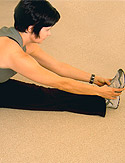Five Ways to Win at Losing

1. Experiment to find your own diet. Some foods are obvious no-nos: trans fats, processed food, white sugar and excessive alcohol. Beyond that, though, everyone's body is different. "Some people thrive on a strictly high-protein diet, while others do great with fruits, grains and beans," says Jillian. "Sometimes it takes a lot of trial and error to find the right combination of foods. And, as a trainer, I've learned that you also have to take human frailty into account. If you can't bear the idea of giving up bread, choose whole grain and try to eat it with some protein." The protein, she explains, will slow the breakdown of the bread so its carbs won't cause your blood sugar to spike and then—as so often happens—crash, making you hungry again for something starchy.
2. Don't ever starve yourself. Dieting means cutting calories, but less isn't always more. "One of the biggest misconceptions I've seen—including among the women I'm training on the show—is that the less you eat, the more weight you'll lose," says Jillian. "Maybe at first. But your body will think you're dying from lack of food, and your metabolism will adjust by slowing to a crawl." Most women should never eat less than 1,200 calories a day.
3. Tough it out. Accept that the early days of a fitness program may not be fun. "You've just got to push through," says Jillian. "Your body is an amazing machine. After two weeks, the walk that used to have you sucking wind won't even tire you. It took only that long for the women on The Biggest Loser to discover they could do exercises they initially found impossible. By the end of the first month, you'll see some pretty significant changes. That's when I get calls from my clients: 'Oh my God, I felt my hip bone!'"
4. Just forget about your thighs. Try viewing exercise as helping you increase what you're able to do, rather than fixing a "flawed" body part. "Whenever I start working with women, I hear complaints like 'My thighs are too big' or 'What can I do about my butt?'" says Bob. "Once you get someone moving, however, that can change to, 'Wow, I never knew how weak I was.' Being aware of a flaw can be good for getting you started, but it's more productive to think about being fit and healthy than about how you look." When you become aware of how physically strong you can be, adds Jillian, "it translates into all other areas of your life."
5. Keep your perspective. Don't count on getting the spectacular body of a movie star—unless, that is, you were blessed with a naturally great figure. And certainly don't blame yourself for not measuring up (or down, as the case may be). "Celebrities have private chefs; trainers like me working with them 24 hours a day, 6 days a week; and plastic surgeons to fix whatever problems are left," says Jillian. And then there's good lighting, airbrushing and all sorts of photographic wizardry. "Hollywood," she adds, "is a very small piece of the world. It is not reality."



